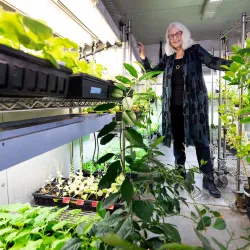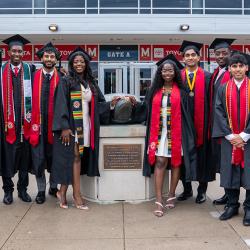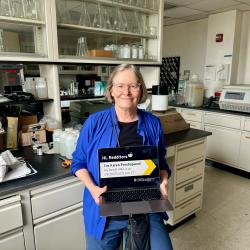Cell Biology and Molecular Genetics Professor Anne Simon Answers Questions About Citrus Greening
The College of Computer, Mathematical, and Natural Sciences hosted a Reddit Ask-Me-Anything spotlighting plant virology research.

University of Maryland Cell Biology and Molecular Genetics Professor Anne Simon participated in an Ask-Me-Anything (AMA) user-led discussion on Reddit to answer questions about quantum computing on March 12, 2025.
Simon studies plant viruses and examines how they can be used to help stop citrus greening disease, which has wiped out hundreds of millions of citrus trees in the U.S. and worldwide. Citrus greening is spread by tiny insects called psyllids, which inject disease-causing bacteria into a tree’s vascular system. Simon’s lab and the company she co-founded, Silvec Biologics, have developed an approach to combat this disease by infecting trees with a virus that delivers antibiotic agents to the location where the bacteria live.
This Reddit AMA has been edited for length and clarity.
Do plants/trees have something analogous to an immune system? If so, how does it compare to our immune systems? Aside from disease-carrying insects, how else do viruses spread? Is there something analogous to norovirus for plants, where they can catch an infection from how the virus affects the plant?
Plants have an innate immune system, which animals also have. But there is no adaptive immune system like animals. Plants also have susceptibility genes that must be expressed for bacterial and fungal pathogens to infect.
Viruses have specific vectors that allow them to spread. Some use insects like aphids. Some use beetles, fungi, parasitic plants, etc. The main thing is that it is specific to the virus. Some viruses do not have any known vector—for example, tobacco mosaic virus. TMV spreads by people cutting diseased plants and then cutting a non-diseased plant, for example.
One really cool thing that some viruses do is they cause the plants to put out a scent that attracts their insect vector to the infected plant so that it can pick up the virus and spread it.
Is selective breeding of citrus a main reason why they are so vulnerable to disease?
There are about 400 different varieties of citrus, and right now, very very few are resistant to the bacteria. Certainly, scientists are working on breeding resistant trees, and they are also working on making genetically modified trees that would be resistant to the bacteria. The problem is that getting a GMO tree through the regulatory process would take at least a decade, and maybe $20 million. By then, it would really be too late.
How common is it for plant viruses to “jump” hosts? Like if there’s a virus that specifically infects, say, brassicas, is it possible or likely that it could also start infecting, say, nightshades? What would have to happen for that to be a thing?
It would be very unusual for a virus to jump hosts beyond its current host range. Hosts have the right proteins for the virus to replicate and assist in movement.
If we are to start using genetically modified viruses for plant cellular and gene therapy, we will need to find a suitable virus that offers infectivity through a wide range of species. Which plant virus is currently seen as the best candidate? Is there something analogous to AAV for cell and gene therapy in humans?
Right now, the best plant virus vector is the tobacco rattle virus (TRV). It has 400 different hosts, from tobacco to some fruit trees. A good virus vector is symptomless and cannot be transmitted from plant to plant. When put in a plant, it cannot infect any other plants. Also, it must be stable with the insert inside its genome. This is the biggest problem—the stability of the plant virus vector. My lab and company have figured out how to keep hairpin inserts (and maybe much larger inserts) stable in the virus. Our paper on this should be out this month in the Journal of Virology.
Why did your lab focus on making an antibiotic virus to already sick trees, rather than targeting the psyllids with something like neutered males as is done with the screwworm in Central America?
Targeting the psyllid is not simple. Insecticidal sprays have not worked. We are starting to work on also delivering proteins that are anti-psyllid, along with the antibacterial peptides. We have just been using this virus as a vector for citrus greening in the past 18 months, and everything takes a very long time in citrus. But we are working as fast as we can, literally 24/7, to come up with a solution. I wish that I had started in this area 10 years ago.
There are abandoned orange groves all over Florida and when I drive through them, there appear to be a fair amount of trees with healthy-looking oranges. Why can’t we study the trees that are doing well and see what kind of resistance they have?
The healthy-looking trees are likely ones being injected with the antibiotic right now. Most of the trees were too far gone to be helped. None of these trees is resistant to the bacteria. Everyone is worried about antibiotic-resistant bacteria, because when this happens, then the antibiotic treatments will not be successful, and the remaining trees will fail. There is a substantial amount of research going on to try to understand why a few varieties of citrus are resistant. It appears as if one is resistant because it produces a particular defensin, and that is one of the defensins that we are looking at as well to be delivered by the virus to varieties that don't produce this particular peptide.
Is it possible to develop viruses that adapt to antibiotic resistance in the pathogenic bacteria while in the host?
Antibiotic resistance is a big concern, which is why there needs to be a more permanent solution. Also, the injection site inside the tree is black, not a good outcome for the longevity of the tree. Injections are also back-breaking; they must be done right above the roots in two locations and removed the following day.
How easy is it to infect massive numbers of trees with a plant virus? How many viruses are most citrus plants are already infected with generally? Will Silvec Biologics have to devise a new vector for different geographic areas? Will there have to be a new antibacterial viral vector every season?
Our virus vector, citrus tristeza virus (CTV), is endemic in Florida. However, we know how to superinfect these trees. So if a tree is already infected, it does not impede the virus vector. The CTV that we use is a Florida isolate. We would like to use it in California and Texas as well, which have a similar virus in their trees, and we are working with both states to see if this is possible. The virus should permanently infect the trees. Right now, there should not be a problem adding the virus to seedlings, but we would really like to save the mature trees as well. We are hoping to be able to determine if this is possible starting this year.
What genetic pipelines do you use in your work, and do you work with microbial communities as part of your work?
There are scientists working to understand if strengthening the microbiome can help the tree better survive this bacterial infection. So far, I have not heard that this is going to be successful in the short term. We really need a way to vaccinate the trees so that the bacteria never take hold.
So far, what are the viral pathways you observed in your research, and how does it affect the speed at which the virus infects a plant cell?
Viruses move through connections between plant cells called plasmodesmata. They do this because the cell wall keeps viruses from bursting out of cells like some animal viruses can do. All plant viruses (with one exception) encode at least one movement protein, which is required for transiting plasmodesmata. The one exception is a virus we found called umbra-like viruses. Many of these viruses use a host protein for movement. It would be difficult to speed up how a virus does things naturally. For mature citrus trees, we are going to try topping the trees because the virus likes to move quickly into new growth.
If the worst comes to pass, would it be possible to switch our citrus cultivars, like what happened with Gros Michel to Cavendish for bananas?
The problem is, you really don't want to eat the fruit of the citrus that they have found to be resistant, and there are 400 varieties of citrus grown for consumption. So, unfortunately, there isn't a solution like for the banana, which has very few edible varieties.
Are there actions that everyday people can take to help prevent the spread of these citrus (and other) plant viruses?
Citrus greening is caused by a bacterium called Candidatus Liberibacter Asiaticus, which is delivered to plants by its psyllid vector. The tree has a very bad reaction to this bacterium and kills itself within about five years by blocking its veins, causing roots to die. It is so important that people follow the requirements for importing citrus and sending pieces of citrus in the mail. In other words, never do this. One citrus graft from the mail that was grafted onto a pomelo tree in southern California has led to the entire state of California being in fear of losing its citrus industry. Probably the same thing happened in Florida. And now, 95% of Florida's citrus industry is gone.







